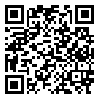BibTeX | RIS | EndNote | Medlars | ProCite | Reference Manager | RefWorks
Send citation to:
URL: http://jhr.ssu.ac.ir/article-1-339-en.html

 , Fatemeh Mehravar *2
, Fatemeh Mehravar *2 
 , Farhad Kord3
, Farhad Kord3 
 , Samieh Ghana4
, Samieh Ghana4 
 , Seyyed Ali Aghapour5
, Seyyed Ali Aghapour5 
 , Rasoul Mohammadi6
, Rasoul Mohammadi6 
 , Leila Fazeli Aref3
, Leila Fazeli Aref3 
 , Ahmad Heidari7
, Ahmad Heidari7 

2- Clinical Research Development Unit (CRDU), 5 azar Hospital, Golestan University of Medical Sciences, Gorgan, Iran ,
3- Deputy Treatments, Golestan University of Medical Sciences, Gorgan, Iran
4- Schools of Nursing and Midwifery, Golestan University of Medical Sciences, Gorgan, Iran
5- Children's Hospital Taleghani, Golestan University of Medical Sciences, Gorgan, Iran
6- Shahid Beheshti University of Medical Sciences, Tehran, Iran
7- Clinical Research Development Unit (CRDU), 5 azar Hospital, Golestan University of Medical Sciences, Gorgan, Iran
Introduction: Trauma is one of the most common health problems worldwide, which results in many cases of physical disability every year. Considering the importance of the occurrence of trauma, this study was conducted to determine its epidemiology in trauma patients of the Trauma Center of Gorgan County, Golestan Province.
Methods: This cross-sectional population-based study was conducted on 17941 Iranian trauma patients attending the Trauma Center of 5 Azar Educational Hospital, Gorgan County, from the beginning of 2013 through 2014 using the census method. The patients’ data were collected using a checklist designed by the Treatment Deputy of Golestan University of Medical Sciences on morning, evening, and night shifts by trained personnel. The data were analyzed with the STATA software version 12.
Results: Most of the trauma patients were male and belonged to the age group 21-35 years. Alley, street, and house were the most common trauma locations. Injury, motorcycle accident, and falls from height were the most common types of trauma. As for the outcome, most trauma patients were “treated”.
Conclusion: With advances in technology, due to the increase in the number and speed of vehicles and changes in the lifestyle, trauma is one of the major causes of mortality and disability in the world. Knowledge of the epidemiology of trauma in the world can help to lower its prevalence and incidence.
Received: 2016/11/1 | Accepted: 2017/05/28 | Published: 2017/06/6
| Rights and permissions | |
 |
This work is licensed under a Creative Commons Attribution 4.0 International License. |



